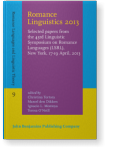On capacities and their epistemic extensions
The purpose of this paper is twofold; first, we aim to provide a series of tests that identify Spanish ser capaz ‘be capable’ (henceforth SC) as an ambiguous modal, just like English must or can. Specifically, we observe that SC has not only an abilitative flavor, but also an epistemic one. Second, we want to propose an analysis for SC that can account for this ambiguity and that is in accordance with current theories of modality such as Cinque (1999), Kratzer (1981, 1991), and Hacquard (2009, 2010). In a nutshell, we argue that SC can occupy two different positions, a low one below AspP, which corresponds to the abilitative interpretation, and a high one, above AspP, which translates as the epistemic reading. Concerning the semantics, we claim that SC denotes a slight possibility; i.e., the propositional argument is true in at least one world, but it is always true in the non-ordinary worlds.
References (22)
References
Bhatt, Rajesh. 1999. “Ability Modals and their Actuality Entailments.”
Proceedings of WCCFL 17
. Ed. by Kimary N. Shahin, Susan Blake, and Eun-Sook Kim, 74–87.
Cinque, Guglielmo. 1999. Adverbs and Functional Heads: A Crosslinguistic Perspective. Oxford Studies in Comparative Syntax. Oxford and New York: Oxford University Press.
Cross, Charles B. 1986. “‘Can’ and the Logic of Ability.” Philosophical Studies 50 (1): 53–64. 

Escandell Vidal, María Victoria. 2004. Fundamentos de Semántica Composicional. Ariel.
von Fintel, Kai and Anthony S. Gillies. 2007. “An Opinionated Guide to Epistemic Modality.” In Oxford Studies in Epistemology, Vol. 2. Ed. by Tamar S. Gendler and John Hawthorne, 36–62. Oxford: Oxford University Press.
Giannakidou, Anastasia. 2001. The Meaning of Free Choice. Linguistics & Philosophy 24: 659–735. 

Giannakidou, Anastasia and Elena Staraki. 2013. “Ability, Action, and Causation: From Pure Ability to Force,” In Genericity. Ed. by Alda Mari, Claire Beyssade and Fabio Del Prete. Oxford University Press.
Hackl, Martin. 1998. On the Semantics of Ability Attributions. Ms, MIT.
Hacquard, Valentine. 2006. Aspects of Modality. Ph.D. Thesis, MIT.
Hacquard, Valentine. 2009. “On the Interaction of Aspect and Modal Auxiliaries.” Linguistics & Philosophy 32(3): 279–315. 

Hacquard, Valentine. 2010. “On the Event Relativity of Modal Auxiliaries.” Natural Language Semantics 18(1): 79–114. 

Kenny, Angelica. 1975. Will, Freedom and Power. Oxford: Basic Blackwell.
Kratzer, Angelika. 1981. “The Notional Category of Modality.” In Words, Worlds, and Contexts. Ed. by Hans-Jürgen Eikmeyer, Hannes Rieser, 38–74. Walter de Gruyter.
Kratzer, Angelika. 1991. “Modality.” In Semantics: An International Handbook of Contemporary Research. Ed. by Arnim von Stechow and Dieter Wunderlich, pp. 639–650. De Gruyter.
Mari, Alda. 2011. Modalités et Temps: Des Modèles aux Données. Ms. Institut Jean Nicod (Habilitation à diriger des recherches).
Mari, Alda and Fabienne Martin. 2007. “Tense, Abilities and Actuality Entailment.” In Proceedings of the Sixteenth Amsterdam Colloquium. Ed. by Maria Aloni, Paul Dekker und Floris Roelofsen, 151–156.
Picallo, M. Carme. 1990. “Modal verbs in Catalan.” Natural Language & Linguistic Theory. 8(2): 285–312. 

Piñón, Christopher. 2003. “Being Able To.” In Proceedings of WCCFL 22. Ed. by Gina Garding and Mimu Tsujimura, 384–397.
Portner, Paul. 2009. Modality. Oxford University Press.
RAE y Asociación de Academias de la Lengua Española. 2010. Nueva Gramática de la Lengua Española. Madrid: Espasa. [NGRALE]
Ross, John Robert. 1969. “Auxiliaries as Main Verbs.” In Studies in Philosophical Linguistics Series I. Ed. by William Todd, 79–102.
Thalberg, Irving. 1972. Enigmas of Agency: Studies in the Philosophy of Human Action. London: Allen and Unwin.
Cited by (1)
Cited by one other publication
Mari, Alda
2016.
Actuality Entailments: When the Modality is in the Presupposition. In
Logical Aspects of Computational Linguistics. Celebrating 20 Years of LACL (1996–2016) [
Lecture Notes in Computer Science, 10054],
► pp. 191 ff.

This list is based on CrossRef data as of 9 december 2022. Please note that it may not be complete. Sources presented here have been supplied by the respective publishers.
Any errors therein should be reported to them.
